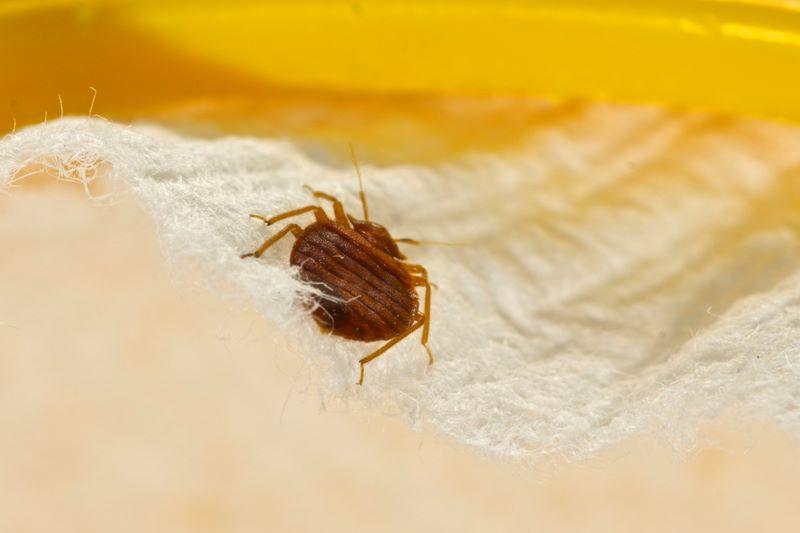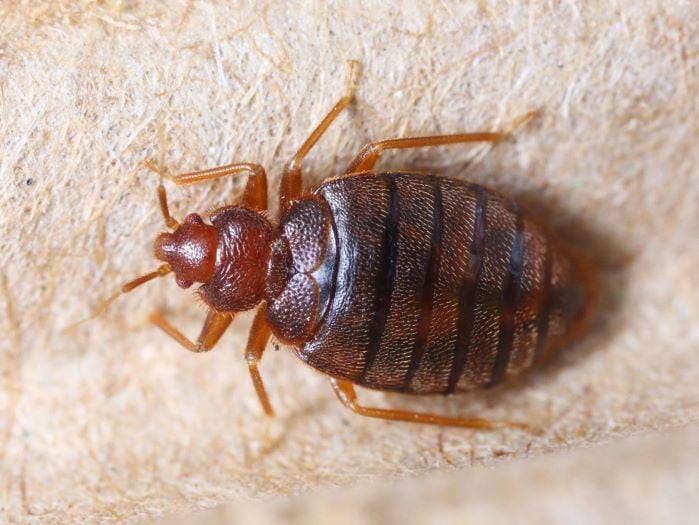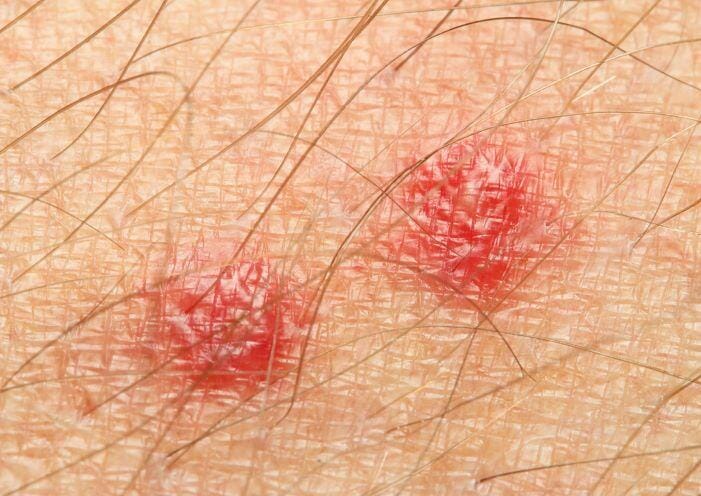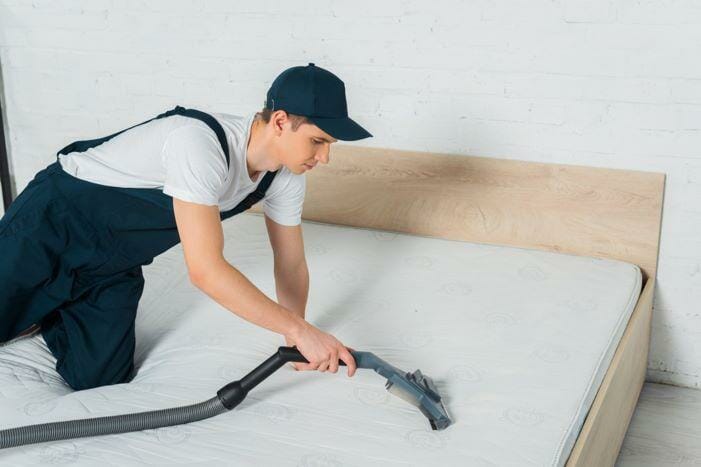How to Get Rid of Bed Bugs Naturally
When you lie down in bed each night, the last thing you want to think about is bed bugs.
Unfortunately, bed bugs are very common.
In fact, one out of five Americans has had a bed bug infestation in their home or knows someone who has experienced bed bugs either at home or in a hotel.
Here at Smith's Pest Management, we provide bed bug control services to customers in and around the Francisco Bay Area. Thanks to this experience, our team knows how to get rid of bed bugs from all locations—including single-family homes, commercial facilities, hotels, and more.
In this post, we'll share a few of our top tips forhow to get rid of bed bugs on your own–without an exterminator–and when to call in the pros.
Let's dive in.

What are Bed Bugs?
Since a healthy female bed bug can lay up to 500 eggs in her lifetime, you can wind up with a serious infestation in a matter of just weeks.

What Attracts Bed Bugs to Your Home?
Many people believe bed bugs love dirty conditions, and that they're attracted by filth. This is why many people believe that sleeping in a cheap hotel is a surefire way to get bed bugs.
As it turns out, though, that's just acommon misconception.
Bed bugs are not drawn to dirt or decay. In fact, they can live in any environment, as long as they have access to the one thing they need to survive:
Blood.
Unlike mosquitoes and ticks, which are also blood-eating insects, bed bugs can't fly or live on their hosts. Instead, they must hide near their food source and wait for a meal to become available to them.
As such, bed bugs are highly adaptable. They can live anywhere from the cushions of a sofa to the carpet of a library, as long as they can access regular blood meals.
If you have bed bugs in your apartment, that's why!
With that in mind, here are a few main causes of bed bugs:
- Purchasing used furniture and bringing it into the home. Bed bugs can enter your space via luggage, purses, backpacks, used couches, and more.
- Cross-contamination in a multi-unit environment. Bed bugs can travel between rooms in apartment complexes and hotels.
- Contamination from a hotel, resort, or hostel. Bed bugs may get into your clothing or luggage and come home with you.
- New people staying in your home. Guests may come to stay at your home, bringing bed bugs with them without knowing.
4 Signs of a Bed Bug Infestation In Your Home

Bed bugs are tiny–usually no larger than the point of a pen–so it can be hard to spot them at first. If you think you may have a bed bug infestation, keep an eye out for these signs:
- Evidence of the bugs themselves, such as shed skins or black droppings in mattress seams or other items.
- Bites, welts, or bumps on your body in the morning after you get out of bed.
- Tiny blood stains on your sheets or pillowcases.
- An offensivemusty odorin your room or around your bed, which some people say reminds them of "locker room smell."
While realizing you have bed bugs can be alarming, identifying them is the first step to treating them.
How to Get Rid of Bed Bugs: 5 Steps To Take Right Now

Once you've identified a bed bug infestation, it's time to act. Follow these steps to get rid of the pests:
Step 1: Identify infested areas
Since bed bugs multiply quickly, it's essential to find them before they start to reproduce. With that in mind, inspect the following areas for signs of bed bugs:
- The seams of your mattress and box spring.
- Cracks between your bed frame and headboard.
- Between the cushions of your sofa, and along the seams of the cushions.
- Along the seam of your carpets, where the carpet meets the wall.
- In the joints of furniture like couches, accent chairs, and futons.
Use a flashlight and check each area carefully. Look for tiny dark or rust-colored droppings, live bedbugs, or small pale yellow eggs.
If you find signs of bedbugs in any of these places, you'll also want to check your nightstand, dresser drawers, and closet.
Step 2: Contain the bugs
Once you've identified an active bed bug infestation, you have to contain it so it doesn't spread. One quick and easy way to contain live bed bugs is by sucking them up with your vacuum.
To contain live bedbugs, thoroughly vacuum your mattress, the insides of your dresser, the seams and joints of your furniture, your carpets, and any other place you've noticed signs of bed bug infestation.
When you're finished, seal the contents of your vacuum canister in a plastic bag and throw it away. Keep in mind that this will not get rid of the bed bug infestation–it will only pick up live bed bugs. If there are eggs left behind, they may still hatch and cause a secondary infestation.
Once you've vacuumed all affected areas, wash and dry affected linens, clothing, and other textiles in hot water and on a high-heat setting in your dryer. If you cannot wash and dry an item (a couch cushion, for example), use steam to kill bed bugs instead.
More on both approaches in the next section.
Step 3: Kill the bed bugs
Now it's time to actually get rid of the bed bugs once and for all. Here's how:
3 Natural Home Remedies
1. Get rid of bed bugs naturally with heat or cold
Temperature is an effective way to get rid of bed bugs in a mattress or other important area. With that in mind, gather affected bedding or clothing and wash it in very hot water for 30 minutes. Once the wash cycle is done, dry the items in your dryer on the highest possible heat setting for at least 30 minutes. Alternately, put affected items in a freezer that is at least 0 degrees Fahrenheit. Leave them there for four days to make sure all bed bugs are dead.
Pros: Non-toxic, easy, effective
Cons: Not possible for all items or materials
2. Use steam
To kill bed bugs without an exterminator: Use a steamer on mattresses, couches, and other places where bed bugs hide.
Pros: Safe, easy, effective, can be used as both a preventative treatment and a bed bug killing treatment
Cons:Requires a steamer, which not everyone has, may damage certain materials or fabrics
3. Cover mattresses
Purchase bed bug-proof covers to place around your mattress and box spring. When zipped all the way up, these covers will prevent bed bugs from entering, and will kill bed bugs trapped inside: They also form a protective barrier that prevents the bed bugs from biting you while you sleep.
Pros: Effective, affordable, non-toxic, simple
Cons: Does not remove bed bugs from the mattress
Conventional Bed Bug Treatments
1. Use an insecticide
If home remedies don't appeal to you to get rid of bed bugs, you can turn to insecticides. Pyrethrins and pyrethroids are two common insecticides used to kill bed bugs. As far as pesticides go, these have a relatively low toxicity to pets and people, and are fast-acting.
They also require a low dose to kill insects. The drawback, however, is that some bed bugs are resistant to these chemicals. In that case, you (or your exterminator) may need to use an alternate insecticide, such as pyrroles like chlorfenapyr, or neonicotinoids, which are synthetic versions of nicotine.
Pros:Effective and fast-acting, ideal for killing bed bugs in homes and hotels
Cons: May contain harsh chemicals that some people do not want in their home
2. Use a desiccant
Desiccants are substances that kill bugs by destroying their protective coating. Without this coating, the bugs dry out and die. Two popular desiccants are silica aerogel and diatomaceous earth. Bed bugs cannot become resistant to desiccants, and these substances have a high kill rate.
Pros: Relatively safe, effective, easy to deploy
Cons: Can be messy, require more regular reapplication than insecticides
3. Deploy a bug bomb
What kills bed bugs instantly? Bug bombs. Foggers and bug bombs both kill bed bugs and are good broadcast solutions. They are, however, highly toxic to both people and pets, and will require you to vacate your home while they go to work.
Pros: Effective and fast-acting
Cons: Dangerous, highly toxic, cannot get into cracks and crevices where bed bugs hide, so may be less effective than direct-application insecticides
Step 4: Monitor affected areas
Bed bug infestations can take weeks or even months to wipe out. To make sure your treatment is working, check the infested area once a week for a few months. If you notice new signs of bedbug activity, treat the area again.
Step 5: Hire a pro
The fastest and most effective way to get rid of bed bugs is to hire a professional exterminator, like Smith's Pest Management in San Jose, CA.
Our team will evaluate your bed bug infestation and make a plan to remove all bugs and restore the peace and tranquility of your home.
How do Pest Control Experts Get Rid of Bed Bugs?

If DIY bed bug control isn't an option, you can hire a professional exterminator like Smith's. Here's the process our team follows to get rid of bed bugs:
1. Inspect the property and develop a management plan
Every pest control job we conduct starts with an inspection and consultation. We first inspect the affected areas of your home and property to locate bed bugs and identify inspections.
Based on that inspection, our techs will develop a management plan to get rid of the bed bugs permanently. We'll also discuss bed bug treatment costs with you so you can budget for removal.
2. Deploy treatment
Next, our pest control experts will get to work actually treating your bed bug infestation. We offer a selection of bed bug treatment options, including the following:
Heat Treatment
Heat treatment is ideal for large infestations in homes or hotels. These treatments are non-toxic and safe for people and pets, and will get rid of the entire infestation in just one visit. During heat treatments, we raise the internal temperature of your home to a level that bed bugs cannot survive. This method penetrates walls as well, which means it's excellent for killing bed bugs in a couch or other hard-to-reach places.
Steam Treatment
Steam treatment is similar to heat treatment, but it works on a smaller scale. These treatments are a good fit for less extensive infestations, and for customers who want a non-toxic solution.
Chemical Treatment
Chemical treatments are effective for minor infestations that are caught early, or for infestations that require spot treatment. These treatments often require one to two follow-up visits to eliminate all bed bugs.
Preventative Options
We offer preventive products like mattress encasements, which will help you prevent bed bug infestations. When used in conjunction with other methods, preventative methods can help keep your houses bed bug-free.
How to Keep Bed Bugs Away from Your Home
When it comes to pest control, preventing an infestation is always easier than controlling it later. With that in mind, here are a few ways to keep bed bugs from invading your home:
- To prevent bed bugs on clothes, be vigilant. When you stay in a hotel,keep your suitcase on a suitcase stand rather than on the floor.Wash all your clothingwhen you return home and put them in a hot dryer.
- Be careful acquiring used furniture. Check all new and used furniture before you bring it inside, including inspecting all seams, joints, tufts, and under cushions.
- Purchase aplastic or hypoallergenic cover for your mattress, box springs, and furniture to prevent bedbugs from entering the textiles.
- Get rid of clutterthat could help bed bugs hide in your home. Paper, magazines, clothes, and other items should be picked up off the floor and nightstands and dressers should be cleaned regularly.
- Vacuum your mattress and floors often. Wash all sheets, clothing, and textiles at least once a week in hot water.
- Use caulk to seal cracksaround baseboards, electrical outlets, light sockets, and furniture, so bed bugs can't hide in them.
- Check for bed bugs in hotels, hostels, and guest rooms you sleep in.
Are Bed Bugs Invading Your San Francisco Bay Area Home or Business? We're Here to Help!
Nobody wants to live with bed bugs. Fortunately, you don't have to!
Here at Smith's Pest Management, we help residential and commercial properties in Northern California—from Marin to Monterey—get rid of bed bugs once and for all, and help you understand how to beat bed bugs on your own.
Contact us today to learn more about our services or to schedule your bed bug removal: (408) 471-6988
How to Get Rid of Bed Bugs Naturally
Source: https://smithspestmanagement.com/blog/post/how-to-get-rid-of-bed-bugs/